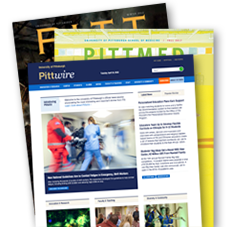Pitt Professor Jeffrey Schwartz Named Fellow of the World Academy of Art and Science
PITTSBURGH—Jeffrey Schwartz, a University of Pittsburgh professor of anthropology and history and philosophy of science and a fellow in Pitt's Center for Philosophy of Science, has been named a fellow of the World Academy of Art and Science.
The World Academy is a nonofficial network of approximately 500 individual fellows from diverse cultures, nationalities, and intellectual disciplines, chosen for eminence in the arts, the natural and social sciences, and the humanities. Its activities focus on the social consequences and policy implications of knowledge and the challenges confronting people in a rapidly changing global civilization. It has in several instances chosen to concentrate on such issues as biotechnology and genetic resources well ahead of general public recognition of their importance.
Schwartz, also a research associate in the Department of Anthropology at the American Museum of Natural History in New York and a faculty member in the Wecht Institute of Forensic Science and Law at Duquesne University School of Law, was among 27 fellows selected for admission to the World Academy. Criteria used in selecting candidates include distinction or accomplishment in one's profession, interdisciplinary interests or accomplishments, a record of public service, and a global perspective in scholarly research.
Originator of the orangutan theory of human origins, Schwartz first revealed his orangutan hypothesis in a 1984 issue of the journal Nature. His book The Red Ape: Orang-utans and Human Origins (Houghton Mifflin Company, 1987) provides more evidence for his theory and fully explains his rationale. An updated and totally revised edition of The Red Ape was published this year by Westview Press. In it, Schwartz analyzes many recent fossil discoveries and incorporates new plates and drawings in support of his belief that Asian orangutans are our closest nonhuman cousins.
Schwartz and colleague Ian Tattersall, curator of anthropology at the American Museum, embarked on a major undertaking a decade ago when they began the study of the human fossil record. With Wiley and Sons, they have published a three-volume
compendium that includes descriptions, photographic images, diagrams, and drawings of virtually the entire human fossil record. Human Fossil Record, Volume 1 (John Wiley and Sons, 2002) won the 2002 Professional Scholarly Publishing Award in the category of Single Reference Sciences.
In addition, Schwartz is now working on a forensic reconstruction of George Washington to depict him at three stages of his life—ages 19, 45, and 57. When completed, the life-size models will be on display in a new education center at George Washington's Mount Vernon Estate and Garden.
###
3/31/05/tmw
Media Resources
Schools of the Health Sciences Media Relations
For more information about Pitt's schools of dental medicine, health and rehabilitation sciences, medicine, nursing, pharmacy, and public health, click here >
To locate stories from health science schools prior to 2013, visit the UPMC news archives »
Urgent Question?
University of Pittsburgh news reps are available to answer urgent media inquiries. Outside of regular business hours (Mon-Fri, 8:30 a.m.-5 p.m.), please email us at media@pitt.edu.
News reps for University of Pittsburgh Health Sciences schools can be reached outside of regular business hours through the paging operator at 1+412-647-2345.


